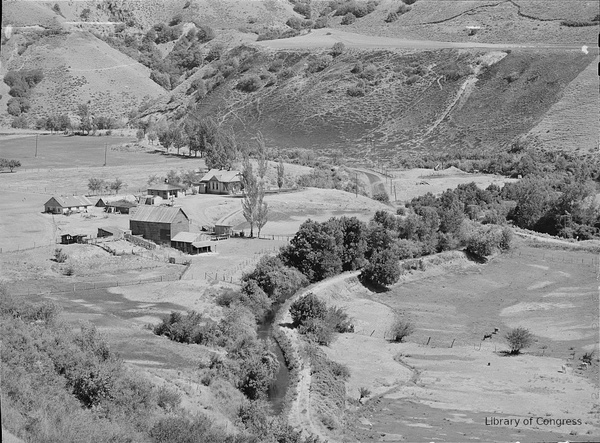Dublin Core
Title
The Desert Land Act in Utah
Description
When Congress passed the Desert Land Act in 1877, the intention was to improve the prospects of individual family farmers homesteading in the arid West. But what actually happened was far different.
In the Civil War era, policymakers in Washington encouraged westward migration by passing laws so that family farmers could claim a piece of land to make a living on. Farming requires water, so homesteading efforts became more difficult west of the 100th meridian where rainfall decreases significantly.
Congress attempted to address this with the Desert Land Act of 1877. The legislation acknowledged the necessity of irrigation for farmers in the far West, but it ultimately demonstrated how little Congress really understood about conditions here. The act allowed for homesteaders to claim a full square mile, or 640 acres, so long as they could irrigate it in three years. This was simply far too much work for one household, while also being too little land for ranching. The act also assumed that sources of surface water were readily available near all of these prospective plots of land, which was not the case.
The legislation was a boon for land speculators and ranchers, but not the family farmers for whom it was intended. Loopholes allowed ranching operations to claim pieces of land near scarce watering holes, and wealthy investors faced little consequence for committing outright fraud to scoop up numerous plots of land. The Deseret News responded to the legislation by calling it “advantageous only to capitalists and speculators.” Even Western governors, including Utah’s, encouraged abuse of the act because they wanted to give Western ranching a leg up over Eastern cattle operations.
Across the West, fraud and abuse plagued the implementation of the Desert Land Act. But Utah was exceptional in that regard. There is little evidence of outright fraudulent claims occurring in Utah. Mormon settlers already had thirty years to develop irrigation systems, and they had done so with communal labor coordinated by their church leadership. After 1877, one thing was clear: agriculture in the Intermountain West would take root with cooperative, not individual, labor. With little need for more marginal lands – and little capital to dedicate toward land speculation – Utahns largely stayed out of the fray.
In the Civil War era, policymakers in Washington encouraged westward migration by passing laws so that family farmers could claim a piece of land to make a living on. Farming requires water, so homesteading efforts became more difficult west of the 100th meridian where rainfall decreases significantly.
Congress attempted to address this with the Desert Land Act of 1877. The legislation acknowledged the necessity of irrigation for farmers in the far West, but it ultimately demonstrated how little Congress really understood about conditions here. The act allowed for homesteaders to claim a full square mile, or 640 acres, so long as they could irrigate it in three years. This was simply far too much work for one household, while also being too little land for ranching. The act also assumed that sources of surface water were readily available near all of these prospective plots of land, which was not the case.
The legislation was a boon for land speculators and ranchers, but not the family farmers for whom it was intended. Loopholes allowed ranching operations to claim pieces of land near scarce watering holes, and wealthy investors faced little consequence for committing outright fraud to scoop up numerous plots of land. The Deseret News responded to the legislation by calling it “advantageous only to capitalists and speculators.” Even Western governors, including Utah’s, encouraged abuse of the act because they wanted to give Western ranching a leg up over Eastern cattle operations.
Across the West, fraud and abuse plagued the implementation of the Desert Land Act. But Utah was exceptional in that regard. There is little evidence of outright fraudulent claims occurring in Utah. Mormon settlers already had thirty years to develop irrigation systems, and they had done so with communal labor coordinated by their church leadership. After 1877, one thing was clear: agriculture in the Intermountain West would take root with cooperative, not individual, labor. With little need for more marginal lands – and little capital to dedicate toward land speculation – Utahns largely stayed out of the fray.
Creator
By Nate Housley for Utah Humanities © 2023
Source
Image: Farmstead and irrigation ditch, Logan, Utah, 1940. Nineteenth-century settlement in Cache County was directed by the LDS Church, and the church-based community typically dug irrigation canals like the one pictured. Rather than simply serving this one, seemingly isolated farmstead, the canal would have flowed through the entire community and required maintenance and cooperation in dividing up its water. This model of communal labor proved to be a more workable model than expecting each individual household to construct their own irrigation works. Courtesy Library of Congress.
_______________
See Stephen W. Stathis, “Utah’s Experience with the Desert Land Act,” Utah Historical Quarterly 48 no 2 (Spring 1980); John T. Ganoe, “The Desert Land Act in Operation, 1877–1891, Agricultural History 11 no 2 (April 1937).
_______________
See Stephen W. Stathis, “Utah’s Experience with the Desert Land Act,” Utah Historical Quarterly 48 no 2 (Spring 1980); John T. Ganoe, “The Desert Land Act in Operation, 1877–1891, Agricultural History 11 no 2 (April 1937).
Publisher
The Beehive Archive is a production of Utah Humanities. Find sources and the whole collection of past episodes at www.utahhumanities.org/stories.
Date
2023-10-27

